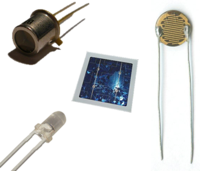
MOF-Based Chemiresistive Gas Sensors: Toward New Functionalities.
Sign Up to like & getrecommendations! Published in 2022 at "Advanced materials"
DOI: 10.1002/adma.202206842
Abstract: The sensing performances of gas sensors must be improved and diversified to enhance the quality of life by ensuring health, safety, and convenience. Metal-organic frameworks (MOFs), which exhibit an extremely high surface area, abundant porosity,… read more here.
Keywords: gas; gas sensors; mof based; based chemiresistive ... See more keywords

Designing polymeric sensing materials: what are we doing wrong?
Sign Up to like & getrecommendations! Published in 2017 at "Polymers for Advanced Technologies"
DOI: 10.1002/pat.3893
Abstract: Natural Sciences and Engineering Research Council (NSERC) of Canada; Canada Research (CRC) program; AUTO21. read more here.
Keywords: sensing materials; designing polymeric; materials wrong; polymeric sensing ... See more keywords

State of the Art in Alcohol Sensing with 2D Materials
Sign Up to like & getrecommendations! Published in 2020 at "Nano-Micro Letters"
DOI: 10.1007/s40820-019-0363-0
Abstract: A current review on the applications of graphene and other two-dimensional (2D) materials in alcohol detection. A thorough discussion on the fundamental principles and the advantages of using 2D materials in sensing alcohol. Critical discussion… read more here.
Keywords: sensing materials; alcohol sensing; art alcohol; alcohol ... See more keywords

Recoverable Dual-Modal Responsive Sensing Materials Based on Mechanoluminescence and Thermally Stimulated Luminescence toward Noncontact Tactile Sensors.
Sign Up to like & getrecommendations! Published in 2023 at "Inorganic chemistry"
DOI: 10.1021/acs.inorgchem.2c03540
Abstract: Tactile sensing with stress and temperature sensing as core elements have shown promising prospects in intelligent robots and the human-machine interface. Mechanoluminescence (ML)-based stress sensing can realize the direct sensing of mechanical stimulation, whereas indirect… read more here.
Keywords: thermally stimulated; sensing materials; temperature; mechanoluminescence ... See more keywords

Application of Polyoxometalates in Chemiresistive Gas Sensors: A Review.
Sign Up to like & getrecommendations! Published in 2022 at "ACS sensors"
DOI: 10.1021/acssensors.2c02341
Abstract: Polyoxometalates (POMs) are a series of molecular metal compounds based on W and Mo elements, exhibiting excellent physical and chemical properties. POMs have been widely used in the fields of photoelectric materials, catalytic materials, and… read more here.
Keywords: gas; gas sensors; poms based; sensing materials ... See more keywords

Designing oxide chemiresistors for detecting volatile aromatic compounds: recent progresses and future perspectives.
Sign Up to like & getrecommendations! Published in 2022 at "Chemical communications"
DOI: 10.1039/d2cc01563c
Abstract: Oxide chemiresistors have mostly been used to detect reactive gases such as ethanol, acetone, formaldehyde, nitric dioxide, and carbon monoxide. However, the selective and sensitive detection of volatile aromatic compounds such as benzene, toluene, and… read more here.
Keywords: aromatic compounds; volatile aromatic; designing oxide; sensing materials ... See more keywords

Research Progress of Gas Sensing Performance of 2D Hexagonal WO3
Sign Up to like & getrecommendations! Published in 2021 at "Frontiers in Chemistry"
DOI: 10.3389/fchem.2021.786607
Abstract: Metal oxide semiconductor gas sensing materials have attracted great research interest in the gas sensor field due to their outstanding physical and chemical properties, low cost, and easy preparation. Among them, two-dimensional hexagonal tungsten trioxide… read more here.
Keywords: sensing materials; research progress; progress gas; gas sensing ... See more keywords

Recent Advances in the Use of CoPc-MWCNTs Nanocomposites as Electrochemical Sensing Materials
Sign Up to like & getrecommendations! Published in 2022 at "Biosensors"
DOI: 10.3390/bios12100850
Abstract: Cobalt phthalocyanine multiwalled carbon nanotubes (CoPc-MWCNTs), a nanocomposite, are extraordinary electrochemical sensing materials. This material has attracted growing interest owing to its unique physicochemical properties. Notably, the metal at the center of the metal phthalocyanine… read more here.
Keywords: mwcnts nanocomposites; copc mwcnts; sensing materials; electrochemical sensing ... See more keywords

Recent Advances in Sensing Materials Targeting Clinical Volatile Organic Compound (VOC) Biomarkers: A Review
Sign Up to like & getrecommendations! Published in 2023 at "Biosensors"
DOI: 10.3390/bios13010114
Abstract: In general, volatile organic compounds (VOCs) have a high vapor pressure at room temperature (RT). It has been reported that all humans generate unique VOC profiles in their exhaled breath which can be utilized as… read more here.
Keywords: sensing materials; voc sensing; voc; exhaled breath ... See more keywords

Modeling and Optimization of Sensitivity and Creep for Multi-Component Sensing Materials
Sign Up to like & getrecommendations! Published in 2023 at "Nanomaterials"
DOI: 10.3390/nano13020298
Abstract: Pressure sensors urgently need high-performance sensing materials in order to be developed further. Sensitivity and creep are regarded as two key indices for assessing a sensor’s performance. For the design and optimization of sensing materials,… read more here.
Keywords: sensitivity; methodology; sensing materials; sensitivity creep ... See more keywords

Electrospun Fibrous Nanocomposite Sensing Materials for Monitoring Biomarkers in Exhaled Breath
Sign Up to like & getrecommendations! Published in 2023 at "Polymers"
DOI: 10.3390/polym15081833
Abstract: Human−exhaled breath mainly contains water, oxygen, carbon dioxide, and endogenous gases closely related to human metabolism. The linear relationship between breath acetone and blood glucose concentration has been revealed when monitoring diabetes patients. Considerable attention… read more here.
Keywords: electrospun fibrous; breath; sensing materials; fibrous nanocomposite ... See more keywords